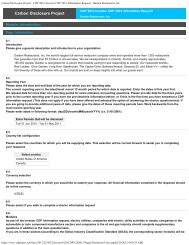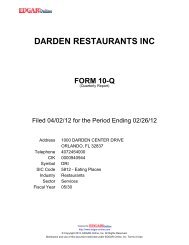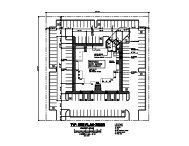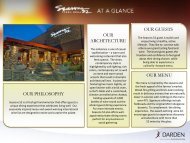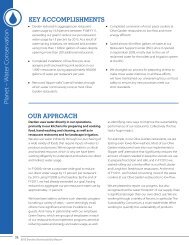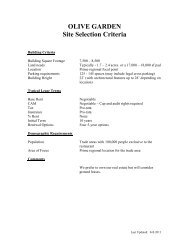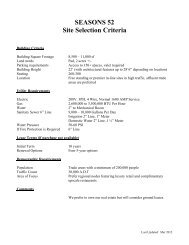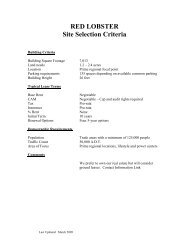2013 Annual Report - Investor Relations - Darden Restaurants
2013 Annual Report - Investor Relations - Darden Restaurants
2013 Annual Report - Investor Relations - Darden Restaurants
Create successful ePaper yourself
Turn your PDF publications into a flip-book with our unique Google optimized e-Paper software.
Notes to Consolidated Financial Statements<strong>Darden</strong>We set the discount rate assumption annually for each of the plans at theirvaluation dates to reflect the yield of high-quality fixed-income debt instruments,with lives that approximate the maturity of the plan benefits. The expectedlong-term rate of return on plan assets and health care cost trend rates are basedupon several factors, including our historical assumptions compared with actualresults, an analysis of current market conditions, asset fund allocations and theviews of leading financial advisers and economists.For fiscal <strong>2013</strong>, 2012 and 2011, we have used an expected long-term rate ofreturn on plan assets for our defined benefit plan of 9.0 percent. In developingour expected rate of return assumption, we have evaluated the actual historicalperformance and long-term return projections of the plan assets, which giveconsideration to the asset mix and the anticipated timing of the pension planoutflows. We employ a total return investment approach whereby a mix of equityand fixed-income investments are used to maximize the long-term return ofplan assets for what we consider a prudent level of risk. Our historical 10-year,15-year and 20-year rates of return on plan assets, calculated using the geometricmethod average of returns, are approximately 9.5 percent, 8.0 percent and9.4 percent, respectively, as of May 26, <strong>2013</strong>. Our Benefit Plans Committee setsthe investment policy for the Defined Benefit Plans and oversees the investmentallocation, which includes setting long-term strategic targets. Our overallinvestment strategy is to achieve appropriate diversification through a mix ofequity investments, which may include U.S., International, and private equities,as well as long-duration bonds and real estate investments. Our target asset fundallocation is 40 percent U.S. equities, 35 percent high-quality, long-durationfixed-income securities, 20 percent international equities, 5 percent real estatesecurities. The investment policy establishes a re-balancing band around theestablished targets within which the asset class weight is allowed to vary. Equitysecurities, international equities and fixed-income securities include investmentsin various industry sectors. Investments in real estate securities follow differentstrategies designed to maximize returns, allow for diversification and provide ahedge against inflation. Our current positioning is neutral on investment stylebetween value and growth companies and large and small cap companies. Wemonitor our actual asset fund allocation to ensure that it approximates our targetallocation and believe that our long-term asset fund allocation will continue toapproximate our target allocation. Investments held in the U.S. commingled fund,U.S. corporate securities, an international commingled fund, U.S. governmentfixed-income securities, an emerging markets commingled fund and a realestate commingled fund represented approximately 41.5 percent, 18.1 percent,14.3 percent, 7.1 percent, 5.9 percent and 4.9 percent, respectively, of total planassets and represents the only significant concentrations of risk related to a singleentity, sector, country, commodity or investment fund. No other single sectorconcentration of assets exceeded 5.0 percent of total plan assets.The discount rate and expected return on plan assets assumptions have asignificant effect on amounts reported for defined benefit pension plans. Aquarter percentage point change in the defined benefit plans’ discount rate andthe expected long-term rate of return on plan assets would increase or decreaseearnings before income taxes by $0.6 million and $0.5 million, respectively.The assumed health care cost trend rate increase in the per-capita chargesfor postretirement benefits was 7.1 percent for fiscal 2014. The rate graduallydecreases to 5.0 percent through fiscal 2021 and remains at that level thereafter.The assumed health care cost trend rate has a significant effect on amountsreported for retiree health care plans. A one percentage point increase or decreasein the assumed health care cost trend rate would affect the service and interestcost components of net periodic postretirement benefit cost by $0.5 million and$0.4 million, respectively, and would increase or decrease the accumulated postretirementbenefit obligation by $6.6 million and $5.2 million, respectively.58 <strong>Darden</strong> <strong>Restaurants</strong>, Inc. <strong>2013</strong> <strong>Annual</strong> <strong>Report</strong>




